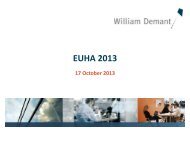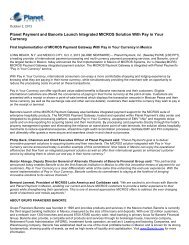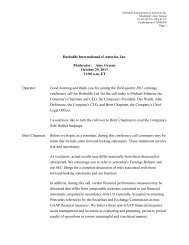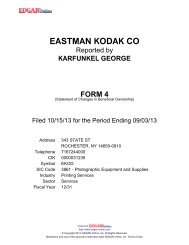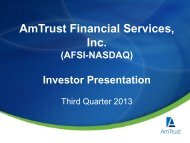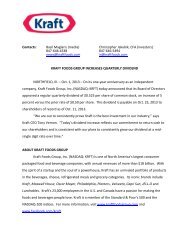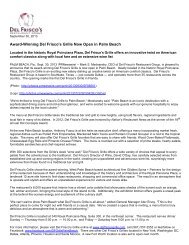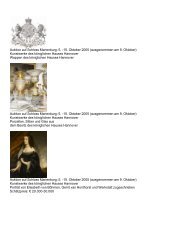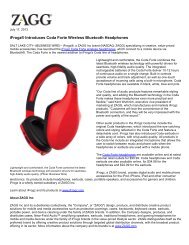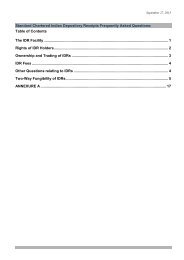matson, inc. form def 14a - Shareholder.com
matson, inc. form def 14a - Shareholder.com
matson, inc. form def 14a - Shareholder.com
Create successful ePaper yourself
Turn your PDF publications into a flip-book with our unique Google optimized e-Paper software.
NEO Base Salary as<br />
of 12/31/08<br />
Amount of<br />
Increase<br />
Annual Incentives: Annual <strong>inc</strong>entives for NEOs are provided through the One-Year Per<strong>form</strong>ance Improvement Incentive Plan (“PIIP”) to motivate executives and reward them if they achieve<br />
specific corporate, business unit and individual goals. These goals are established in February of each year.<br />
Weighting of Goals. The weighting of the corporate, business unit and individual goals depends on the executive’s position and responsibilities. The intention is to place a significant<br />
portion of the awards on the financial results of the Company and business units, but balance that with important strategic goals that have been established for the year through the individual<br />
portion. The 2009 weighting is as follows and was determined by the Compensation Committee to provide proper balance between financial and strategic goals:<br />
Weighting of 2009 PIIP Goals for NEOs<br />
Determination of Annual Cash Incentive Award. Each <strong>com</strong>ponent -- corporate, business unit and individual -- is evaluated against the respective per<strong>form</strong>ance measures and goals. There<br />
are three levels of award opportunities for each <strong>com</strong>ponent: threshold, target and extraordinary. In 2009, target award opportunity levels for NEOs were reduced and ranged from 25 percent to<br />
52.5 percent of salary. In 2010, the normal target award opportunity levels for NEOs range will be reinstated and will range from 50 percent to 90 percent of salary, which is consistent with<br />
<strong>com</strong>petitive targets. If a threshold goal is not achieved, there will be no payout for that <strong>com</strong>ponent. If threshold goals are achieved, a participant will receive 50 percent of the target award<br />
opportunity set for that <strong>com</strong>ponent. If target or extraordinary goals are achieved, a participant will receive 100 or 200 percent, respectively, of the target award opportunity for that <strong>com</strong>ponent.<br />
Awards are prorated for per<strong>form</strong>ance between the threshold, target and extraordinary levels, as applicable. No additional award is provided for per<strong>form</strong>ance above the extraordinary goal level.<br />
The CEO reviews the annual cash <strong>inc</strong>entive award calculations for each individual (other than himself), and makes re<strong>com</strong>mendations to the Compensation Committee regarding payouts,<br />
<strong>inc</strong>luding the reasons for his re<strong>com</strong>mendations. For the 2009 awards however, due to the CEO transition, Mr. Doane assessed the per<strong>form</strong>ance of Mr. Andrasick, Mr. Benjamin, and Mr.<br />
Kuriyama, while Mr. Kuriyama assessed the per<strong>form</strong>ance of Messrs. Buelsing and Cox. The Compensation Committee approves the awards and has discretion to modify re<strong>com</strong>mended awards,<br />
both positively and negatively, to take into consideration factors it believes more appropriately reflect the per<strong>form</strong>ance of the Company, unit, or individual. Such factors may vary, but may<br />
<strong>inc</strong>lude, for individuals, adjustments for an executive taking on temporary but significant additional responsibilities to his normal job role or, for the Company or a business unit, adjustments for<br />
extraordinary events. No such adjustments were made by the Committee for 2009 <strong>inc</strong>entive awards.<br />
Working with Towers Watson-supplied reports and using data as described in the benchmark section on page 21, management and the Compensation Committee reviewed target award<br />
levels for the annual cash <strong>inc</strong>entive awards and confirmed that each NEO is at or below the 50 th percentile and target total cash is below the 50 th percentile for each of the NEOs, as shown in the<br />
table below. In line with other expense reduction measures taken by the Company, target <strong>inc</strong>entive opportunities for 2009 for each NEO were reduced by the Committee by 25 to 50%<br />
percent. The Committee may adjust opportunity targets to more <strong>com</strong>petitive levels at any time it deems it reasonable.<br />
Target Total Cash Positioning for 2009<br />
Base Salary<br />
as of 12/31/09<br />
Estimated<br />
Competitive<br />
Market Percentile<br />
Mr. Doane $803,250 0% $803,250 50<br />
* Salary <strong>inc</strong>rease based on <strong>inc</strong>reased job responsibilities in 2009.<br />
** Mr. Andrasick retired on August 31, 2009. Due to the uniqueness of his role during the transition of his duties and responsibilities, his job could not be <strong>com</strong>petitively evaluated. His<br />
actual <strong>com</strong>pensation was determined under the Executive Transition Agreement.<br />
th<br />
Mr. Kuriyama $400,000 0% $400,000 35 th<br />
Mr. Benjamin $325,000 15.38% $375,000* 45 th<br />
Mr. Andrasick $500,000 0% $500,000 N/A**<br />
Mr. Cox $375,000 6.67% $400,000* 50 th<br />
Mr. Buelsing $300,000 0% $300,000 50 th<br />
NEO Unit Corporate Business<br />
Unit<br />
Individual<br />
Mr. Doane Corporate 70% 0% 30%<br />
Mr. Kuriyama Corporate 70% 0% 30%<br />
Mr. Benjamin Corporate 70% 0% 30%<br />
Mr. Andrasick Transportation 20% 50% 30%<br />
Mr. Cox Transportation 20% 50% 30%<br />
Mr. Buelsing Real Estate 20% 50% 30%<br />
NEO Base Salary<br />
as of 12/31/09<br />
Target<br />
Bonus<br />
2009 Reduced Target Bonus Target Total Cash<br />
as of 12/31/09<br />
(Including Base<br />
Salary)<br />
Estimated<br />
Competitive<br />
Market<br />
Percentile<br />
Mr. Doane $803,250 70% 52.5% $1,224,956 30<br />
* Pro-rated as a result of retirement.<br />
** Actual <strong>com</strong>pensation determined under Executive Transition Agreement.<br />
th<br />
Mr. Kuriyama $400,000 60% 45% $580,000 30 th<br />
Mr. Benjamin $375,000 60% 45% $543,750 40 th<br />
Mr. Andrasick $500,000 55% 41.25% (prorated) $637,500* N/A**<br />
Mr. Cox $400,000 60% 45% $580,000 40 th<br />
Mr. Buelsing $300,000 50% 25% $375,000 30 th<br />
While the Compensation Committee does not anticipate circumstances where a restatement of earnings upon which <strong>inc</strong>entive <strong>com</strong>pensation award decisions were based would occur,<br />
should such circumstances arise the Compensation Committee has the discretion to take necessary actions to protect the interests of shareholders, <strong>inc</strong>luding actions to seek to recover such<br />
<strong>inc</strong>entive awards. In 2009, Towers Watson provided the Committee with an overview of current market practices with regard to recovery or recoupment policies. The Committee plans to<br />
further review this issue in 2010.<br />
Company and Business Unit Per<strong>form</strong>ance . The corporate <strong>com</strong>ponent measure in 2009 was based on the operating plan approved by the Board of Directors and was weighted 65 percent<br />
on corporate profit before <strong>inc</strong>ome tax and 35 percent on return on invested capital (“ROIC”). Per<strong>form</strong>ance goals for the Transportation and Real Estate units were weighted 65 percent on<br />
business unit profit before <strong>inc</strong>ome tax and 35 percent on ROIC. Profit before <strong>inc</strong>ome tax was selected as a per<strong>form</strong>ance <strong>com</strong>ponent because the Company believes it best reflects the results of<br />
business execution and profitability levels. ROIC was chosen as a per<strong>form</strong>ance <strong>com</strong>ponent because it is a key measure in identifying how effectively the Company is investing its capital<br />
resources. The Company believes that both per<strong>form</strong>ance goals align shareholder and executive interests.<br />
The annual corporate and business unit targets reflect the Company’s Board-approved operating plan. When establishing the operating plan, management and the Board of Directors<br />
consider the historical per<strong>form</strong>ance of the Company, external elements such as economic conditions and <strong>com</strong>petitive factors, Company capabilities, per<strong>form</strong>ance objectives, and the Company’s<br />
strategic plan.<br />
If per<strong>form</strong>ance with respect to a corporate or business unit <strong>com</strong>ponent is below the threshold level, there is no <strong>inc</strong>entive payout made for that <strong>com</strong>ponent. The target levels for corporate<br />
and business unit goals were set at 100 percent of the 2009 Board-approved operating plan amounts. Should the Company or any business unit exceed the extraordinary level of per<strong>form</strong>ance,<br />
awards are capped at the extraordinary level. However, the Compensation Committee believes that part of its role is to apply in<strong>form</strong>ed discretionary judgment to the goals and achievements.<br />
For determination of award levels for 2009, the Company’s 2009 operating per<strong>form</strong>ance was <strong>com</strong>pared to the per<strong>form</strong>ance goals approved by the Compensation Committee in January<br />
2009. Corporate goals and actual results were as follows:<br />
Corporate Goal Threshold Target Extraordinary Actual<br />
Profit Before In<strong>com</strong>e Tax $104,291,250 $139,055,000 $166,866,000 $71,808,200



